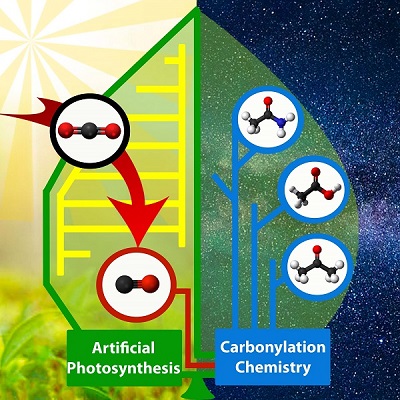CO2 REDUCTION, A CHALLENGE FOR CHEMISTS
Using sunlight to valorize carbon dioxide (CO2) represents an ideal concept and a methodological challenge that could help support a sustainable, carbon-neutral economy. Specialists in bioinspired catalysis (or artificial photosynthesis) have been working for several years on the design of ever more efficient and "clean" catalysts for CO2 reduction, a field in which Joliot teams have already achieved some impressive results. However, the question of the total transformation of CO2 into carbon monoxide (CO) and the fate of the CO produced, a toxic and unstable molecule, remains unresolved. In particular, excess unreacted CO2 can interfere with the subsequent functionalization of CO through various side reactions.
NEW PARTNERSHIP TO VALORIZE REDUCED CO2
In 2018, the institute's artificial photosynthesis specialists (Winfried Leibl's team, I2BC department, in collaboration with Pr Ally Aukauloo, ICMMO, Orsay), had joined forces with the Carbon Isotope Exchange specialists at SCBM (Laboratoire de Marquage au Carbone 14 directed by Davide Audisio). Together, they had proposed a strategy for the immediate reuse of CO produced by photocatalysis of 13C-labelled CO2 in a carbonylation reaction (introduction of CO into an organic or inorganic compound). For this purpose, they used a two-chamber system (COwareR two-chamber system) consisting of a first cell for CO photoproduction, coupled to a second chamber in which the CO is used in a carbonylation reaction, without opening the device (diagram, artist's view). The appeal of the approach lay in the possibility of manipulating and using stable 13C-labelled or radioactive 14C-labelled CO2 as a source of CO for subsequent incorporation of labelled carbon into compounds of pharmaceutical interest (see Valorisation of carbon dioxide for the labeling of pharmaceutical compounds). Promising results, however, revealed the limits of the conversion of CO2 into CO, which did not exceed 30%.

Artist's view (© P.Gotico / CEA) illustrating the "light" and "dark" sides of artificial photosynthesis.
OPTIMIZATION AND SUCCESS OF THE COLLABORATION
In the present study, these same teams have succeeded in developing an optimized photocatalytic process that enables complete and rapid conversion of CO2 to CO (<10 min) and direct valorization of the latter via carbonylation reactions on a variety of substrates, including bioactive compounds of pharmaceutical interest. In fact, the researchers were able to label a structurally diverse library of derivatives, such as amides, esters, ketones, aldehydes and carboxylic acids, in a single step from CO2. The method is suitable for all carbon isotopes (13C, 14C and 11C), opening up new opportunities for direct access to 11C- and 14C-labeled pharmaceuticals from their primary isotopic sources [11C]CO2 and [14C]CO2. Kinetic simulations based on reaction models have also been carried out to rationally optimize the various reactions.
CONCLUSION
From the collaboration initiated in 2018, which was featured on the cover of ChemPhotoChem (issue 8, 2018), comes a new groundbreaking study, published in Nature Communications, that extends the scope of applications for photocatalytic CO2 reduction to the synthesis of radiolabeled and pharmaceutically relevant drugs, a necessary step in studying their biodistribution in our body (drug ADME studies).
Contacts : Winfried Leibl (winfried.leibl@cea.fr) and Philipp Gotico (philipp.gotico@cea.fr) for bioinspired photocatalysis, Davide Audisio (davide.audisio@cea.fr) for carbon isotope labeling and CO radiochemistry, Fabien Caillé (fabien.caille@cea.fr) for carbon-11 labeling.